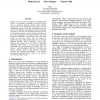Free Online Productivity Tools
i2Speak
i2Symbol
i2OCR
iTex2Img
iWeb2Print
iWeb2Shot
i2Type
iPdf2Split
iPdf2Merge
i2Bopomofo
i2Arabic
i2Style
i2Image
i2PDF
iLatex2Rtf
Sci2ools
AIPS
2000
2000
New Results about LCGP, a Least Committed GraphPlan
Planners from the family of Graphplan (Graphplan, IPP, STAN...) are presently considered as the most efficient ones on numerous planning domains. Their partially ordered plans can be represented as sequences of sets of simultaneous actions. Using this representation and the criterion of independence, Graphplan constrains the choice of actions in such sets. We demonstrate that this criterion can be partially relaxed in order to produce valid plans in the sense of Graphplan. Our planner LCGP needs fewer levels than Graphplan to generate these plans (the same number in the worst cases). Then we present an experimental study which demonstrates that, in classical planning domains, LCGP "practically" solves more problems than planners from the family of Graphplan (Graphplan, IPP, STAN...). In most cases, these tests demonstrate the best performances of LCGP. Then, we present a domain-independent heuristic for variable and domain ordering. LCGP is thus improved using this heuristic...
AIPS 2000 | Artificial Intelligence | Numerous Planning Domains | Partially Ordered | Planning Domains |
| Added | 01 Nov 2010 |
| Updated | 01 Nov 2010 |
| Type | Conference |
| Year | 2000 |
| Where | AIPS |
| Authors | Michel Cayrol, Pierre Régnier, Vincent Vidal |
Comments (0)

